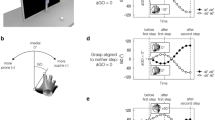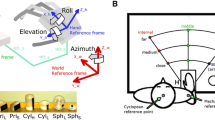Abstract
A habitual and a goal-directed system contribute to action selection in the human CNS. We examined to which extent both systems interact when selecting grasps for handling everyday objects. In Experiment 1, an upright or inverted cup had to be rotated or moved. To-be-rotated upright cups were more frequently grasped with a thumb-up grasp, which is habitually used to hold an upright cup, than inverted cups, which are not associated with a specific grasp. Additionally, grasp selection depended on the overarching goal of the movement sequence (rotation vs. transport) according to the end-state comfort principle. This shows that the habitual system and the goal-directed system both contribute to grasp selection. Experiment 2 revealed that this object-orientation-dependent grasp selection was present for movements of the dominant- and non-dominant hand. In Experiment 3, different everyday objects had to be moved or rotated. Only if different orientations of an object were associated with different habitual grasps, the grasp selection depended on the object orientation. Additionally, grasp selection was affected by the horizontal direction of the forthcoming movement. In sum, the experiments provide evidence that the interaction between the habitual and the goal-directed system determines grasp selection for the interaction with every-day objects.


Similar content being viewed by others
Notes
Please note that the selection of a grasp posture itself can be considered as setting the (sub-) goal to assume a specific posture at the moment of grasping. Thus, also habitually selected grasping postures may result in necessarily goal-directed grasping movements. This apparent contradiction arises because the selection of the grasp posture may be considered as the result of an action selection process when observed from the task perspective (e.g. rotating an object) but as a goal itself when observed from the movement perspective (e.g. grasping an object with prone forearm orientation).
The excluded participants used the following grasps: upright–upright: 2× handle, 3×thumb-up; upright-inverted: 1× thumb-up, 2× thumb-down, 2× handle; inverted-upright: 1× thumb-down, 4× handle; inverted–inverted: 3× thumb-up, 1× handle, 1× error (participant did not rotate cup).
As no videos were recorded in Experiment 1, we analyzed handle grasps in Experiment 2. In Experiment 2, 6 out of 16 handle grasps were non-functional with respect to drinking.
In one trial, the participant rotated the cup using a thumb-down grasp but placed it on the far circle. After additional instruction, he moved the cup to the near circle without rotating it, using a thumb-up grasp. This trial was included in the analysis as thumb-down trial.
We report Greenhouse-Geisser corrected P-values but uncorrected F-values.
Please note that left-to-right movement and right-to-left movements differed not only in the direction of the movement but also with respect to the location of the start- and end-point. As start point and end-point were only 12 cm apart, we believe that the direction of the movement is the main source of the observed effects.
References
Balleine BW, Dickinson A (1998) Goal-directed instrumental action: contingency and incentive learning and their cortical substrates. Neuropharmacol 37(4–5):407–419. doi:10.1016/S0028-3908(98)00033-1
Butz MV (2006) Rule-based evolutionary online learning systems. Springer, Berlin
Butz MV, Herbort O, Hoffmann J (2007) Exploiting redundancy for flexible behavior: unsupervised learning in a modular sensorimotor control architecture. Psychol Rev 114(4):1015–1046. doi:10.1037/0033-295X.114.4.1015
Cisek P (2007) Cortical mechanisms of action selection: the affordance competition hypothesis. Philos Trans R Soc B: Biol Sci 362:1585–1599. doi:10.1098/rstb.2007.2054
Cohen RG, Rosenbaum DA (2004) Where grasps are made reveals how grasps are planned: generation and recall of motor plans. Exp Brain Res 157:486–495
Coren S (1993) The lateral preference inventory for measurement of handedness, footedness, eyedness, and earedness: norms for young adults. Bull Psychonomic Soc 31(1):1–3
Creem SH, Proffitt DR (2001) Grasping objects by their handles: a necessary interaction between cognition and action. J Exp Psychol Hum Percept Perform 27(1):218–228
Cruse H (2003) The evolution of cognition—a hypothesis. Cogn Sci 27:135–155. doi:10.1016/S0364-0213(02)00110-6
Daw ND, Niv Y, Dayan P (2005) Uncertainty-based competition between prefrontal and dorsolateral striatal systems for behavioral control. Nat Neurosci 8(12):1704–1711. doi:10.1038/nn1560
Frey SH (2008) Tool use, communicative gesture and cerebral asymmetries in the modern human brain. Philos Trans R Soc B Biol Sci 363(1499):1951–1957. doi:10.1098/rstb.2008.0008
Gentilucci M, Negrotti A, Gangitano M (1997) Planning an action. Exp Brain Res 115:116–128
Haggard P (1998) Planning of action sequences. Acta Psychol 99(2):201–215. doi:10.1016/S0001-6918(98)00011-0
Herbort O, Butz MV (2010) Planning and control of hand orientation in grasping movements. Exp Brain Res 202(4):867–878. doi:10.1007/s00221-010-2191-9
Herbort O, Butz MV (2011) The continuous end-state comfort effect: weighted integration of multiple biases. Psychol Res. doi:10.1007/s00426-011-0334-7
Herbort O, Butz MV, Pedersen G (2010) The SURE_REACH model for motor learning and control of a redundant arm: from modeling human behavior to applications in robotics. In: Sigaud O, Peters J (eds) From motor learning to interaction learning in robots. Springer, Heidelberg, pp 85–106
Janssen L, Beuting M, Meulenbroek R, Steenbergen B (2009) Combined effects of planning and execution constraints on bimanual task performance. Exp Brain Res 192(1):61–73. doi:10.1007/s00221-008-1554-y
Janssen L, Meulenbroek R, Steenbergen B (2011) Behavioral evidence for left-hemisphere specialization of motor planning. Exp Brain Res 209(1):65–72. doi:10.1007/s00221-010-2519-5
Johnson SH (2000) Thinking ahead: the case for motor imagery in prospective judgements of prehension. Cogn 74(1):33–70. doi:10.1016/S0010-0277(99)00063-3
Johnson-Frey SH, McCarty ME, Keen R (2004) Reaching beyond spatial perception: effects of intended future actions on visually guided prehension. Vis Cogn 11(2–3):371–399
Kelso JAS, Buchanan JJ, Murata T (1994) Multifunctionality and switching in the coordination dynamics of reaching and grasping. Hum Mov Sci 13(1):63–94. doi:10.1016/0167-9457(94)90029-9
Masson MEJ, Bub DN, Breuer AT (2011). Priming of reach and grasp actions by handled objects. J Exp Psychol: Hum Percept Perform. doi:10.1037/a0023509
McCarty ME, Clifton RK, Collard RR (1999) Problem solving in infancy: the emergence of an action plan. Dev Psychol 35:1091–1101
Owen AM (1997) Cognitive planning in humans: neuropsychological, neuroanatomical and neuropharmacological perspectives. Prog Neurobiol 53(4):431–450
Oztop E, Bradley NS, Arbib MA (2004) Infant grasp learning: a computational model. Exp Brain Res 158(4):480–503. doi:10.1007/s00221-004-1914-1
Packard MG, Knowlton BJ (2002) Learning and memory functions of the basal ganglia. Annu Rev Neurosci 25:563–593. doi:10.1146/annurev.neuro.25.112701.142937
Rosenbaum DA, Jorgensen MJ (1992) Planning macroscopic aspects of manual control. Hum Mov Sci 11(1–2):61–69. doi:10.1016/0167-9457(92)90050-L
Rosenbaum DA, Marchak F, Barnes HJ, Vaughan J, Siotta JD, Jorgensen MJ (1990) Constraints for action selection: overhand versus underhand grips. In: Jeannerod M (ed) Attention and performance, vol XIII. Lawrence Erlbaum Associates, Hillsdale, pp 321–345
Rosenbaum DA, Vaughan J, Barnes HJ, Jorgensen MJ (1992) Time course of movement planning: selection of handgrips for object manipulation. J Exp Psychol Learn Mem Cogn 18(5):1058–1073
Rosenbaum DA, van Heugten CM, Caldwell GE (1996) From cognition to biomechanics and back: the end-state comfort effect and the middle-is-faster effect. Acta Psychol 94:59–85
Rosenbaum DA, Meulenbroek RGJ, Vaughan J, Jansen C (2001) Posture-based motion planning: applications to grasping. Psychol Rev 108(4):709–734
Short MW, Cauraugh JH (1999) Precision hypothesis and the end-state comfort effect. Acta Psychol 100(3):243–252. doi:10.1016/S0001-6918(98)00020-1
Thibaut J-P, Toussaint L (2010) Developing motor planning over ages. J Exp Child Psychol 105(1–2):116–129. doi:10.1016/j.jecp.2009.10.003
Tucker M, Ellis R (1998) On the relations between seen objects and components of potential actions. J Exp Psychol Hum Percept Perform 24(3):830–846
Waszak F, Wascher E, Keller P, Koch I, Aschersleben G, Rosenbaum DA, Prinz W (2005) Intention-based and stimulus-based mechanisms in action selection. Exp Brain Res 162:346–356. doi:10.1007/s00221-004-2183-8
Weigelt M, Schack T (2010) The development of end-state comfort planning in preschool children. Exp Psychol 6:1–7. doi:10.1027/1618-3169/a000059
Weigelt M, Kunde W, Prinz W (2006) End-state comfort in bimanual object manipulation. Exp Psychol 53(2):143–148. doi:10.1027/1618-3169.53.2.143
Weigelt M, Rosenbaum DA, Huelshorst S, Schack T (2009) Moving and memorizing: motor planning modulates the recency effect in serial and free recall. Acta Psychol 132(1):68–79. doi:10.1016/j.actpsy.2009.06.005
Weiss DJ, Wark JD, Rosenbaum DA (2007) Monkey see, monkey plan, monkey do: the end-state comfort effect in cotton-top tamarins (Saguinus oedipus). Psychol Sci 18(12):1063–1068. doi:10.1111/j.1467-9280.2007.02026.x
Yin HH, Knowlton BJ (2006) The role of the basal ganglia in habit formation. Nat Rev Neurosci 7(6):464–476. doi:10.1038/nrn1919
Author information
Authors and Affiliations
Corresponding author
Electronic supplementary material
Below is the link to the electronic supplementary material.
Rights and permissions
About this article
Cite this article
Herbort, O., Butz, M.V. Habitual and goal-directed factors in (everyday) object handling. Exp Brain Res 213, 371–382 (2011). https://doi.org/10.1007/s00221-011-2787-8
Received:
Accepted:
Published:
Issue Date:
DOI: https://doi.org/10.1007/s00221-011-2787-8




